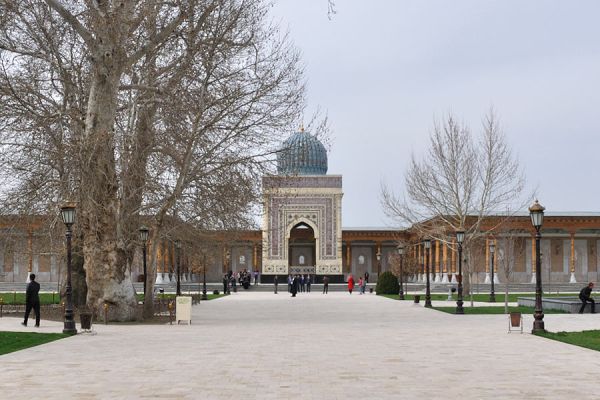Mausoleum of Imam Al-Bukhari
The Mausoleum of Imam Al-Bukhari is one of the most revered Islamic shrines in Central Asia. A distance of about 25-30 km separates the pilgrimage memorial in the village of Khartang from Samarkand. The outstanding theologian Imam Muhammad is buried in this place. After the government decree issued in the spring of 1997 on holding celebrations related to the birthday of Ismail Bukhari (1225 years old), a comprehensive organization of celebrations began.
President Karimov, who heads the state of Uzbekistan, initiated the construction of a memorial connecting a mosque, a theological school, a book depository, and a mausoleum. The best, qualified craftsmen from major Uzbek cities were invited to create the project and build the architectural ensemble.
Architecture and sights of the Imam Al-Bukhari Memorial
The central portal of the Imam Al-Bukhari memorial is made in the form of a large, wrought-iron gate. Commemorative plaques affixed on both sides of the entrance attest to the history of the construction of this structure. In the center of the memorial is a tomb with the relics of Bukhari Ismail, about 17 meters high. The mausoleum building is covered with a dome in the shape of a hemisphere, decorated with sky-blue ceramic tiles. The surface of the walls is lined with ceramic majolica, granite slabs and mosaic tiles. The unique patterns are stylized to match the national ornament of strict geometric shapes connected by delicate plant stems. The tombstone of the burial is made of natural onyx stone, which has a green tint.
In the left part of the memorial ensemble there is a khanaka with a mosque, an adjacent gallery with an area of about 800 square meters, capable of accommodating more than one and a half thousand believers performing prayer. Visiting this Muslim holy place is comparable to staying in Mecca, equating a pilgrimage to it with a small hajj. On the right side of the complex there is a museum with a unique collection of amazing handwritten books, which contain the word of God addressed to devout Muslims. In addition to these mute witnesses to the history of Islam, among the exhibits of the museum are various gifts presented by the leaders of different states. A piece of the kiswa of the Holy Kaaba, donated by the ruler of Saudi Arabia, is also kept here.
In the theological college, located in the depths of the complex, hadith traditions about the actions and instructions of the Prophet Muhammad are studied. Majestic plane trees grow in the courtyard around the pond. At a short distance from the reservoir, a spring breaks through, giving healing moisture to the thirsty.
In order for the whole world to learn as much as possible about the life of Bukhar Ismail and his spiritual legacy, an international foundation was established in 2000 to publish periodicals of a spiritual and educational nature. In theological schools and universities that teach the basics of Islam, books written by the theologian Bukhari are used as educational material to help in the study of the Sunnah.





























